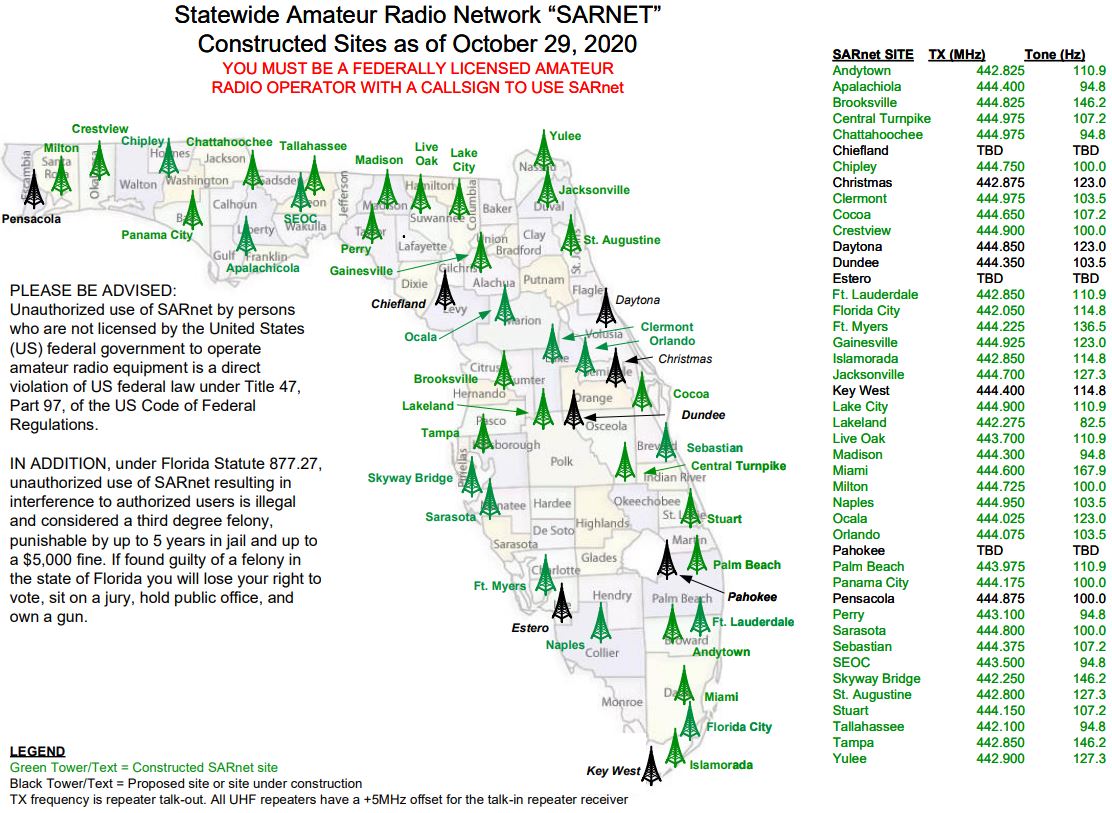SARNET - Florida's State Wide Connected Repeater System
A brief 15-30 sec ad will play at
the start of this feed.
No ads for Premium Subscribers



SARNet Scanner Feed - Florida State Wide
Receiving On Lee County NX4Y Repeater - 444.225 MHz – PL 136.5 - North Fort Myers, Florida
Video About The System Here: https://youtu.be/1GBmv72V_Wk
Feed Maintained by
Ian J. Hickin – KO4EFS - YouTube @StarShipAdventures
Joseph - KM4OVZ - YouTube @ScuffedRadio
www.StarShipAdventures.net | The Southwest Florida Technical Team
GIVE BACK OUR SYSTEM!
Many Amateur Radio operators across Florida are deeply concerned about how the State has taken control of SARNet—the Statewide Amateur Radio Network—right when it’s needed most: during hurricanes and major emergencies.
This once-proud network, built on the backbone of ham radio spirit and volunteerism, is now locked down during disasters. Instead of supporting life-saving communications like weather updates, damage reports, and welfare checks, the system becomes a closed channel, reserved for an elite few. Operators—licensed, trained, and ready—are kicked off their own frequencies. What we get in return? Bureaucrats and self-appointed gatekeepers scolding hams for “unauthorized use,” even when trying to provide critical updates.
During hurricanes Ian, Helene, and Milton, this stream captured what SARNet had become: not a tool for public service, but a platform for power-tripping officials more concerned with authority than communication. It’s frustrating. It’s wrong. And it may lead to this feed being permanently discontinued—because if the system no longer serves the people, what’s the point?
What is SARNet?
SARNet is a network of linked UHF repeaters across Florida, built to provide robust, statewide amateur radio voice communications—even when cell towers and the internet go down. It operates independently from commercial systems, thanks to a dedicated FDOT microwave backbone.
Under normal conditions, SARNet should allow licensed amateurs to communicate statewide with no special setup—just key up your radio on a local linked repeater, and you’re on the network. The network doesn’t rely on the internet or phone lines, which makes it a strong option for true emergency communication.
But here's the catch: during actual emergencies, SARNet becomes restricted. Operators are told to keep off. Traffic is shut down or “controlled.” And that access—the lifeline we’re licensed to provide—is cut off when people need it most.
Why This Matters
The amateur radio community has always stepped up in times of need—quietly, without fanfare, and with real-world results. We’re trained, capable, and federally licensed. It’s time Florida starts respecting the role amateur radio plays in public safety—not just when it’s convenient, but when it truly matters.
We believe SARNet should remain open and accessible during disasters, allowing all qualified hams to contribute. Whether it’s relaying storm reports, requesting help, or simply checking on someone’s safety—this is what ham radio was built for.
Learn More / System Info:
> Receiving on 444.225 MHz (NX4Y Repeater – Lee County)
> System Map & Repeater List: Visit SARNet Website
> Operated by FDOT and monitored by Florida Emergency Management
> Networked via private microwave links—no internet or cellular dependency
If you’re as frustrated as we are, speak up. Share this stream. Contact your local repeater trustee. Let’s take back SARNet for the people who built it—and still stand ready to serve.
> 73s – Ian J. Hickin – KO4EFS
> StarShipAdventures.net | SWFLTech.net


